
Welcome to our informative blog series on "Using a Dehumidifier in Your Crawl Space Without Encapsulation: Effective Moisture Control." In this series, we'll delve into the practical and beneficial aspects of utilizing a dehumidifier to manage moisture levels in your crawl space, even if encapsulation is not part of your strategy. Discover how a dehumidifier can play a crucial role in preventing mold growth, structural damage, and improving indoor air quality without the need for a complete encapsulation process.
Why Choose Dehumidifiers for Moisture Management in Unencapsulated Crawl Spaces
Opting for dehumidifiers to manage moisture in unencapsulated crawl spaces offers a practical and effective solution for maintaining a dry and healthy environment. While encapsulation provides comprehensive protection, dehumidifiers can be a more accessible and budget-friendly choice. They work by extracting excess moisture from the air, preventing the buildup of dampness that can lead to mold growth, wood rot, and structural issues. This approach is especially beneficial if encapsulation isn't feasible due to budget constraints or structural limitations.
Furthermore, dehumidifiers offer targeted moisture control without altering the structural dynamics of your crawl space. They can be strategically placed in central locations, efficiently managing humidity levels without the need for extensive modifications. Dehumidifiers also contribute to improved indoor air quality by reducing the potential for mold spores and allergens to circulate through your home. Ultimately, choosing dehumidifiers for moisture management in unencapsulated crawl spaces offers an effective and versatile method to combat moisture-related problems and create a healthier living environment.
Benefits of Installing Dehumidifiers for Moisture Control in Unencapsulated Crawl Spaces
Installing dehumidifiers in unencapsulated crawl spaces comes with a host of benefits that contribute to a more comfortable and healthier living environment. First and foremost, these devices effectively combat excess moisture, which can lead to a range of issues such as mold growth, wood rot, and musty odors. By maintaining optimal humidity levels, dehumidifiers help prevent these problems from taking root, extending the longevity of your crawl space and the overall integrity of your home.
Additionally, dehumidifiers play a crucial role in
enhancing indoor air quality. Excess moisture in crawl spaces can lead to the proliferation of mold spores and allergens, which can then make their way into your home's air circulation. Installing dehumidifiers helps mitigate this risk, reducing the potential for respiratory issues and allergy flare-ups. As a cost-effective alternative to encapsulation, dehumidifiers provide a targeted and efficient solution for moisture management, ensuring that your crawl space remains dry, well-ventilated, and free from the damaging effects of excess humidity.
Key Factors to Consider When Using Dehumidifiers in Crawl Spaces Without Encapsulation
When utilizing dehumidifiers in crawl spaces without encapsulation, several key factors should be taken into consideration to ensure their effectiveness. First and foremost, proper placement is essential. Position the dehumidifiers in central locations within the crawl space to maximize their coverage and ensure even moisture removal. This strategic placement allows the dehumidifiers to efficiently draw in humid air and expel dry air, contributing to a balanced humidity level.
Another critical factor is the size and capacity of the dehumidifiers. Choose units that are appropriate for the square footage of your crawl space and the humidity levels present. Undersized dehumidifiers may struggle to manage moisture effectively, while oversized units can lead to excessive energy consumption. Regular maintenance, including cleaning the filters and inspecting the drainage system, is essential to ensure optimal performance over time. By carefully considering these factors, you can harness the power of dehumidifiers to effectively manage moisture in your crawl space without the need for encapsulation, fostering a healthier and more comfortable home environment.
FAQs
Contact EAS Environmental Today!
EAS Environmental will do everything we can to ensure your experience with us is excellent.
Request A FREE Estimate
Request a Free Estimate Form
Checkout Recent Post




Got a Question? We’re Here to Help.
You can arrange an appointment or make an enquiry by phone or email, orget in touch to us via our contact form.

